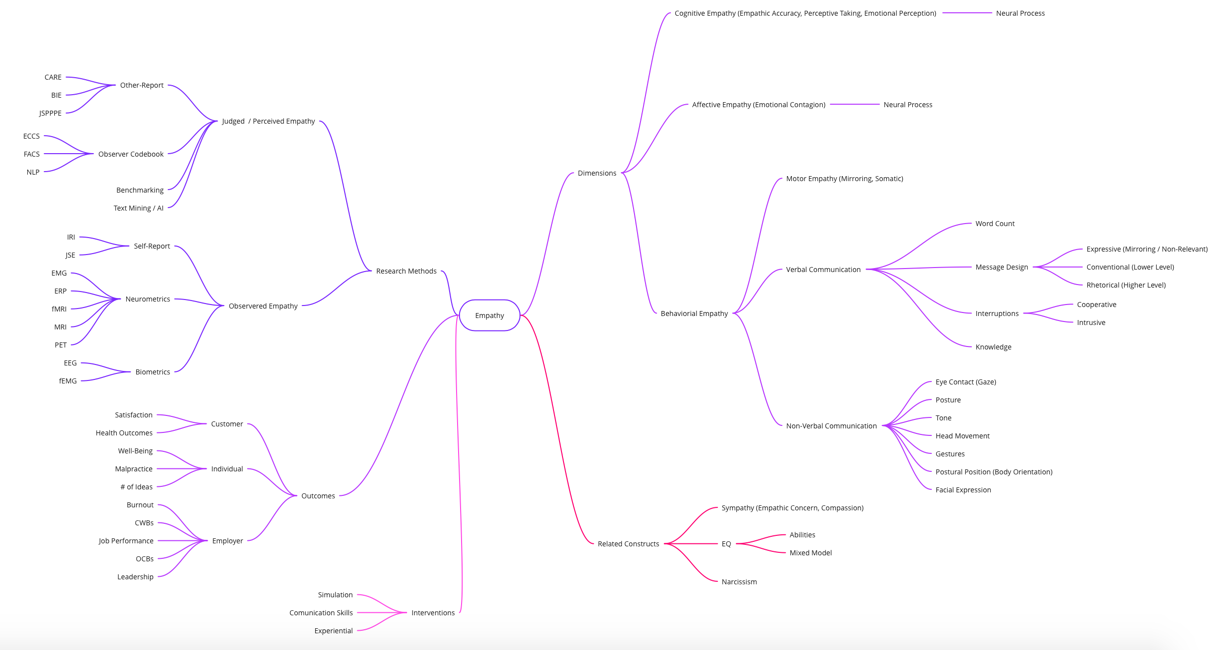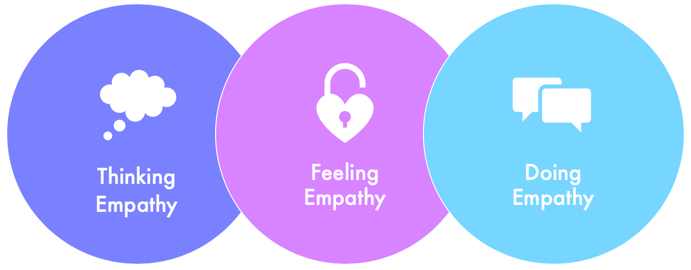Empathy pays. Caring deeply about your customers isn’t just the right thing to do—empathy is good business.
Empirical research shows there is a direct correlation between employee empathy and business outcomes (e.g., profitability, customer satisfaction). Employees with high empathy are less likely to burnout (e.g., call out sick, quit, disengage).
So what exactly is empathy? It’s a term that often gets thrown around, but what does it actually mean to be empathic? What does it look like?

What Empathy Is Not
Empathy is not a synonym for emotional intelligence. Developed by psychologists Peter Salovey and John D. Mayer in 1990, the emotional intelligence ability-based model includes 4 dimensions: perceive emotion (in yourself, others, and other things), use emotion to facilitate thought, understand emotion, and manage emotion. Empathy is one skill among many within the dimension of perceiving emotion.
Empathy is not sympathy. We don’t show empathy by saying “I’m sorry that happened to you” or sending flowers to someone recovering from surgery. Instead, that’s sympathy.
Empathy is not compassion. We don’t show empathy by forgiving an unpaid loan for someone going through a rough financial patch or providing a warm blanket to a homeless person without a coat. Instead, that’s compassion.
Sympathy and compassion are good and noble, but they are not sustainable. Asking employees to consistently display sympathy or compassion will lead to burnout, absenteeism, disengagement, or lower job satisfaction.
What Empathy Is
Psychologist Edward Titchener coined the word empathy in 1909 as a translation of the German term Einfühlung (which in turn was coined by philosopher Robert Vischer in 1873.) Throw that bit of trivia out at your next scrum meeting.
Empathy is made up of 3 dimensions:
- Cognitive empathy
- Affective empathy
- Behavioral empathy
In regular human-speak that means…

- Thinking: Intellectually understand what someone is feeling.
- Feeling: Perceive what someone is feeling.
- Doing: Communicate (words and actions) to someone.
What Does Empathy Look Like?
Because it’s happening in our minds, two-thirds of empathy is completely invisible to the other person. So, the one-third we do show is enormously important.
We visibly demonstrate empathy in 3 ways:
- Mirroring (unconscious imitation)
- Non-verbal communication (body language)
- Verbal communication
Mirroring
Don’t worry too much about mirroring because we all do it instinctively. We may unconsciously match another person’s head tilt, gestures, or rate of speech. Mirroring is a good thing because it creates a bond between people.
Non-Verbal Communication
We can say (or type) all the perfect things and still screw up an “empathy opportunity” if our tone, pitch, body language, or facial expressions are not congruent with our words.
You know how you can tell if someone is truly smiling? You can see it in their eyes. Like a genuine smile, empathy cannot be faked.
Verbal communication
If empathy isn’t saying “I’m sorry,” then what is the right thing to say? In my research, I found this empathy scoring guide, and thought it nicely and clearly demonstrated how to improve our empathy skills.
Highest to lowest levels of empathy expressions*:
6 – Make explicit statement about sharing the customer’s emotion or similar experience
5 – Confirm customer’s expressed emotion
4 – Acknowledge the main issue and follow up with a question or comment
3 – Acknowledge the main issue
2 – Acknowledge a secondary issue
1 – Backchannel response (e.g., I see, hm, ah)
0 – No acknowledgement
*Adapted from Bylund and Makoul’s (2002) “Empathic Communication Coding System.”
In Conclusion
My deep dive into empathy was extremely eye-opening and had me thinking a lot about other ways I might help foster empathy in my work.
For example, next time I create personas I might include a physical space or a supplemental worksheet for teams to write down experiences or emotions they share with the persona. Another idea might be co-creating example scripts or guidance about tone, body language, and word choice—like an “empathy toolkit” for writers and frontline employees.
See also: Can Empathy Be Measured?
See also: Can Empathy Be Taught?